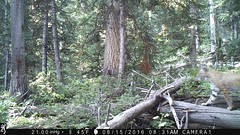Imitation Is the Sincerest Form of Flattery
It’s been about a year since I’ve finished my first painting, and this is it. I’m posting this now as I’m reorganizing my office, and I’m trying to figure out where to hang it.
It was done in acrylic on plywood (2′ x 4′), and painted over a few months during graduate school. I was originally attempting to just throw down some paint to teach myself about mixing color and getting used to the medium, but I think it turned out pretty good.
This painting was inspired blatantly copied from the cover shot of Catch Magazine, March 2010. The photo was taken by Brian O’Keefe of a nice rainbow being released into the Beaverhead River, Montana. I purchased the image through the magazine and used it as my computer background image for several months before I decided to attempt to paint it.
If you are not a subscriber to Catch Magazine (it’s free!), I highly recommend you check it out if you are an artist or a fly fisher. Brian O’Keefe and Todd Moen have created a beautiful publication that never ends to inspire me to fish, photograph, and paint. http://catchmagazine.net
Nowadays, I usually don’t copy paintings from other works, but you gotta start somewhere.
John the Baptist
“In our family, there was no clear line between religion and fly fishing. We lived at the junction of great trout rivers in western Montana, and our father was a Presbyterian minister and a fly fisherman who tied his own flies and taught others. He told us about Christ’s disciples being fishermen, and we were left to assume, as my brother and I did, that all first-class fishermen on the Sea of Galilee were fly fishermen and that John, the favorite, was a dry-fly fisherman.”
― Norman Maclean, A River Runs Through It and Other Stories
The Beauty of the Brown Trout
On the surface, a brown trout may not be that beautiful, but have you ever really examined one up close? They are a lot like snowflakes. As a whole, they’re very similar. Study a single fish for just a moment and you start to see the unique patterns and colors each fish possesses. Then compare different trout against each other and you’ll start to see the beauty of this fish. There are no two alike. This series was originally inspired by a day on the Williams Fork early this. I caught two dozen fish in a mile stretch of the river, and I was amazed at the color and pattern difference between those fish…all caught in the same river at the same time. Now, compare a selection of the brilliantly colored fall spawners, and you’d have an ever larger spectrum to enjoy.
The first two paintings were from two trout I caught this year. The last painting was directly inspired by Rocky Mountain Angler Randy Hick’s monster brown he caught on the South Platte a few weeks ago. All paintings were done in acrylic on 5″x5″x2″ primed wooden cradle board…in case you’re interested.
Since you’re here, check out Randy’s nice brown he caught on the South Platte a few weeks ago.
The Summer of Carp
As a self-diagnosed hypomanic, I tend to get caught up in obsessions. Sometimes it’s work, sometimes it’s running, and sometimes it’s fly fishing. This summer my obsession was fly fishing for carp, and it was a good year. With over 150 golden ghosts landed this season, I’m still not terribly excited to see snow falling outside my window right now. I suppose I should give it up, and move on to other endeavors for the next few months.
Maybe I’ll go for a run.
BTW, I caught almost every carp this year on a single fly pattern – Hudson’s Mud Bugger. Give it a try next year.















